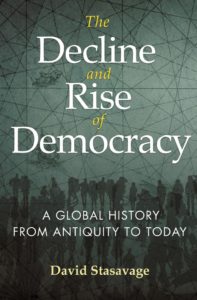 Recent trends – not last democratic backsliding and autocratic resurgence – are enough to make one think that David Stasavage’s new book should have been about the rise and subsequent decline of democracy, not the reverse. So what does history tell us about our current democratic anxieties? he asks.
Recent trends – not last democratic backsliding and autocratic resurgence – are enough to make one think that David Stasavage’s new book should have been about the rise and subsequent decline of democracy, not the reverse. So what does history tell us about our current democratic anxieties? he asks.
We live today in an age of democratic anxiety. In what used to be called the “advanced industrialized” world there is a palpable fear that anti-democratic reflexes not felt for many decades have suddenly reawakened. In parallel, publics have voted for political alternatives that many find shocking and inexplicable. Few would have imagined just a decade ago that the lessons from failed democracies elsewhere would be used to ask whether the United States might suffer the same fate.1 To add to this, in those countries that have recently transitioned to democracy, there are questions whether this movement is less inevitable than it once seemed. The new word of the day for those taking stock of democracy in these countries is backsliding.2 Finally, enduring autocracies like China seem to offer more of an alternative model than they did decades ago.
History suggests that modern democracy is an ongoing experiment, and in many ways, we should be surprised that it has worked at all. Recall the critique levied by John Taylor, soon after the adoption of the U.S. Constitution. He feared that biennial elections to Congress would be but a brief “political spasm” and “one day’s mockery of importance” after which the “5,000” would reassert their dominance over the “5,000,000.” Taylor argued for greater local control where people could participate in a more regular manner and be in closer contact with their representatives. Two hundred and ten years later, a political theorist named John Dunn would say something very similar, and he put it this way.
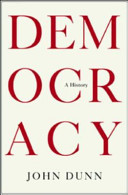 If ancient democracy was the citizens choosing freely and immediately for themselves, modern democracy, it seems, is principally the citizens very intermittently, choosing under highly constrained circumstances, the relatively small number of their fellows who will from then on choose for them. There are many obvious ways in which modern citizens have no need whatever to accept this bargain.3
If ancient democracy was the citizens choosing freely and immediately for themselves, modern democracy, it seems, is principally the citizens very intermittently, choosing under highly constrained circumstances, the relatively small number of their fellows who will from then on choose for them. There are many obvious ways in which modern citizens have no need whatever to accept this bargain.3
The comments by Taylor and Dunn, offered two centuries apart, point to the first fracture point of modern democracy: citizen participation is very broad, but it also risks being very thin. The question then is when citizens will think that this is something other than the sham that Taylor feared. The alternative may be one where democracy either dies or continues only in name as the 5,000—what today we would call the top 0.1 percent—dominate an unequal democracy of the sort that the political scientist Larry Bartels has written about.4
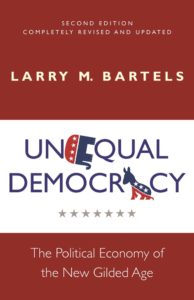 In considering how to design a republic, many eighteenth- and nineteenth-century thinkers took the opposite view from Taylor. They worried that the 5,000,000 would expropriate the wealth of the 5,000. This was not just a fear held by the authors of the Federalist Papers. Throughout western Europe after 1789 political thinkers sought to create republican institutions that would limit the influence of the masses.5 The most obvious way to do this was to limit the suffrage, or to have systems of weighted voting, or to have upper chambers in legislatures to resist popular passions. But these fears turned out to be overdone. Even after universal suffrage was established, there was no massive redistribution of wealth. Wealth inequality did eventually drop, but not as a result of democracy. It was instead wartime events, economic crisis, and also possibly underlying technological changes that led to this shift. History suggests that even in a full democracy, the risk that the 5,000 will dominate is much greater than the threat that the 5,000,000 will expropriate the 5,000.
In considering how to design a republic, many eighteenth- and nineteenth-century thinkers took the opposite view from Taylor. They worried that the 5,000,000 would expropriate the wealth of the 5,000. This was not just a fear held by the authors of the Federalist Papers. Throughout western Europe after 1789 political thinkers sought to create republican institutions that would limit the influence of the masses.5 The most obvious way to do this was to limit the suffrage, or to have systems of weighted voting, or to have upper chambers in legislatures to resist popular passions. But these fears turned out to be overdone. Even after universal suffrage was established, there was no massive redistribution of wealth. Wealth inequality did eventually drop, but not as a result of democracy. It was instead wartime events, economic crisis, and also possibly underlying technological changes that led to this shift. History suggests that even in a full democracy, the risk that the 5,000 will dominate is much greater than the threat that the 5,000,000 will expropriate the 5,000.
The second fracture point of modern democracy concerns executive power. It turns out that an elected leader at the helm of a modern democratic state can sometimes behave just as despotically as an autocrat. In early democracies from the Huron to the Dutch Republic this was simply not possible because power was so decentralized. This decentralization made the system stable, but the disadvantage was inflexibility. The Dutch found this out as the extreme decentralization of their institutions led to economic stagnation—local interests created barriers to entry into markets that stifled innovation.
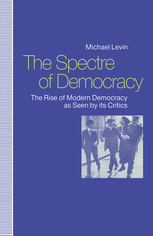 The English pioneered the prototype for the centralized executive in modern democracy. During the medieval era, European monarchs generally dealt with representative assemblies that had substantial blocking power. Localities could constrain their representatives with strict mandates. They could refuse individual decisions. Sometimes they could even refuse to participate. In England all of these constraints disappeared by the end of the fourteenth century. The Crown had succeeded in imposing a more centralized form of rule. Once Parliament established supremacy over the Crown after 1688, it assumed the same role—Parliament had a sort of absolute power. Under the U.S. Constitution, the power of the executive is, in theory, considerably more constrained. But recent decades have seen a considerable growth in executive power via the bureaucracy, particularly when the Congress is divided and/or unable to act. Writing in 2010, Bruce Ackerman, an eminent constitutional scholar, wrote about his fears of “the threat posed by the transformation of the White House into a platform for charismatic extremism and bureaucratic lawlessness.”6 In many minds that is precisely what happened a few short years afterward.
The English pioneered the prototype for the centralized executive in modern democracy. During the medieval era, European monarchs generally dealt with representative assemblies that had substantial blocking power. Localities could constrain their representatives with strict mandates. They could refuse individual decisions. Sometimes they could even refuse to participate. In England all of these constraints disappeared by the end of the fourteenth century. The Crown had succeeded in imposing a more centralized form of rule. Once Parliament established supremacy over the Crown after 1688, it assumed the same role—Parliament had a sort of absolute power. Under the U.S. Constitution, the power of the executive is, in theory, considerably more constrained. But recent decades have seen a considerable growth in executive power via the bureaucracy, particularly when the Congress is divided and/or unable to act. Writing in 2010, Bruce Ackerman, an eminent constitutional scholar, wrote about his fears of “the threat posed by the transformation of the White House into a platform for charismatic extremism and bureaucratic lawlessness.”6 In many minds that is precisely what happened a few short years afterward.
If you are a supporter of democracy—as I am—then the message from this book may be that in spite of these two fracture points of modern democracy, there is reason for hope. Humans have been ruling themselves in a collective fashion since the time they first established settled civilizations and before. Democracy is not something that only occurs at very specific moments, such as classical Athens, Renaissance Italy, and the United States of America.
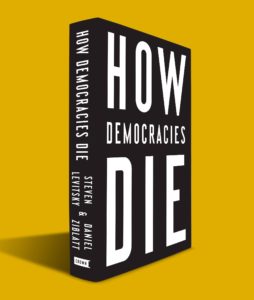 At the same time, we need to recognize that maintaining modern democracy involves two challenges that were not present in earlier variants. These are the risks of strong executive power and citizen distrust. Addressing these requires continual efforts and investments because we must remember that if in modern democracy participation is very broad, it also risks not being very deep. Finally, we need to remember that just because modern democracy survives does not mean that we will be happy with how it performs if the 5,000 dominate over the 5,000,000. Instead of only asking whether democracy will survive, we need to also ask whether we will be satisfied with the democracy that does survive.
At the same time, we need to recognize that maintaining modern democracy involves two challenges that were not present in earlier variants. These are the risks of strong executive power and citizen distrust. Addressing these requires continual efforts and investments because we must remember that if in modern democracy participation is very broad, it also risks not being very deep. Finally, we need to remember that just because modern democracy survives does not mean that we will be happy with how it performs if the 5,000 dominate over the 5,000,000. Instead of only asking whether democracy will survive, we need to also ask whether we will be satisfied with the democracy that does survive.
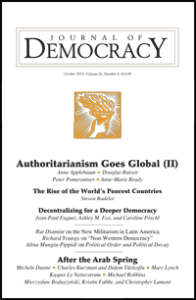 Steven Levitsky and Daniel Ziblatt, How Democracies Die, 2018, have provided the most thorough investigation of this question.
Steven Levitsky and Daniel Ziblatt, How Democracies Die, 2018, have provided the most thorough investigation of this question.- On backsliding, see Ellen Lust and David Waldner, Uwelcome Change: Understanding, Evaluating, and Extending Theories of Democratic Backsliding, 2015; Pippa Norris, “Is Western Democracy Backsliding? Diagnosing the Risks,” 2017; and Nancy Bermeo, “On Democratic Backsliding,” Journal of Democracy, Volume 27, Number 1, January 2016, as well as Steven Levitsky and Lucan Ahmad Way, “The Myth of Democratic Recession.” Journal of Democracy, 26, no. 1 (2015): 45–58.
- See John Dunn, Democracy: A History, 2005, 149.
- Larry M. Bartels, Unequal Democracy: The Political Economy of the New Gilded Age,
- See Michael Levin, The Spectre of Democracy: The Rise of Modern Democracy as seen by its Critics, 1992, for a thorough review of the different arguments made and measures proposed.
- Bruce Ackerman, The Decline and Fall of the American Republic, 2010, 11.
David Stasavage is the Dean for the Social Sciences and the Julius Silver Professor in NYU’s Department of Politics and an Affiliated Professor in NYU’s School of Law. The above extract is taken from his latest book, The Decline and Rise of Democracy: A Global History from Antiquity to Today, published by Princeton University Press.







